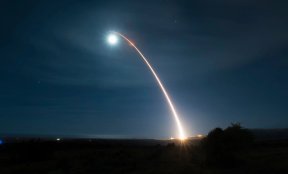Nuke Mars. You’ve probably heard about this, or maybe you have the t-shirt. The idea is simple. Mars has a cold, thin atmosphere that doesn’t support liquid water on its surface. You might think this is a non-problem not looking for a solution, but there is a segment of society intent on moving to Mars, because, why not. So, the plan is to detonate a bunch of nukes above the planet’s polar ice caps causing them to melt and release water vapour into the atmosphere and warm things up. Welcome to paradise.
But the plan is not quite as foolproof and fun as it sounds. First there is the question of how many nukes we’d actually need. According to plans already in motion, we’d require a ‘continuous stream’ of very low fallout nuclear explosions above the atmosphere. If you want a number, let’s say we’re going to need around 10,000 nuclear bombs over a decade or so to provide the estimated 10 Gt of energy that is likely needed. Space launch being what it is, there’s not much to be concerned about, unless you live in Florida.
Detonating nukes as proposed also runs the very real risk of creating a high-altitude haze that might end up blocking solar radiation and thermal emission into the lower atmosphere anyway. That is, rather than melting the ice caps, we might convert the gaseous CO2 (which we want) into solid ice (which we don’t want) making things colder. Not to mention that, even if we did release all the available CO2, it doesn’t seem as though there is enough to make an appreciable difference to atmospheric warming anyway. Oh, and radiation.
And anyway, we’ve tried this before, not on Mars admittedly, but on Earth. If the concept of Peaceful Nuclear Explosions (PNEs) seems like a bit of a contradiction, you should probably know that there was a 1969 proposal to blow the cape (Cape Keraudren) out of northwest Western Australia and create a new harbour to ship iron ore to our friends to the north (Japan). Yes, there was a Test Ban Treaty in existence at the time, but if no-one bothered to measure the radiation released into the atmosphere after the blasts (plural), then who’s to say that there was any? The Soviets wouldn’t have complained too loudly about the US nuking Australia. In the end, the project was stopped before it really started, not because of the risks associated with the blast and radioactivity, but because nobody wanted to pay for it.
But Cape Keraudren was only one proposal under the US government’s Operation Plowshare, a PNE project that ran for nearly two decades. The Soviets had their own version under the typically Soviet moniker of Nuclear Explosions for the National Economy. Between the two superpowers they detonated nearly 200 nukes in the name of peace, in a concerted effort to show that widening the Panama Canal, creating underground aquifers, building dams, and drilling for natural gas was far easier to do with the big red button than digging in the old-fashioned way. Eventually the whole concept fell over because, you know, money. Oh, and radiation.
So, terraforming with nukes has been tried before, and it didn’t work. Nuking Mars will not make it habitable. And besides, Mark Watney wasn’t trying to stay on Mars, he was trying to leave. For good reason. Thin unbreathable atmosphere, extreme temperatures, cosmic and solar radiation, reduced gravity, isolation, limited water, lack of food, lack of infrastructure, lack of energy, distance from Earth, etc., etc. But hey, ‘nuke Mars’ sounds cool. Great way to sell a few t-shirts and solidify a cult of personality. Maybe that was the idea all along?
TL;DR – nuking Mars will not make it a great place to live






